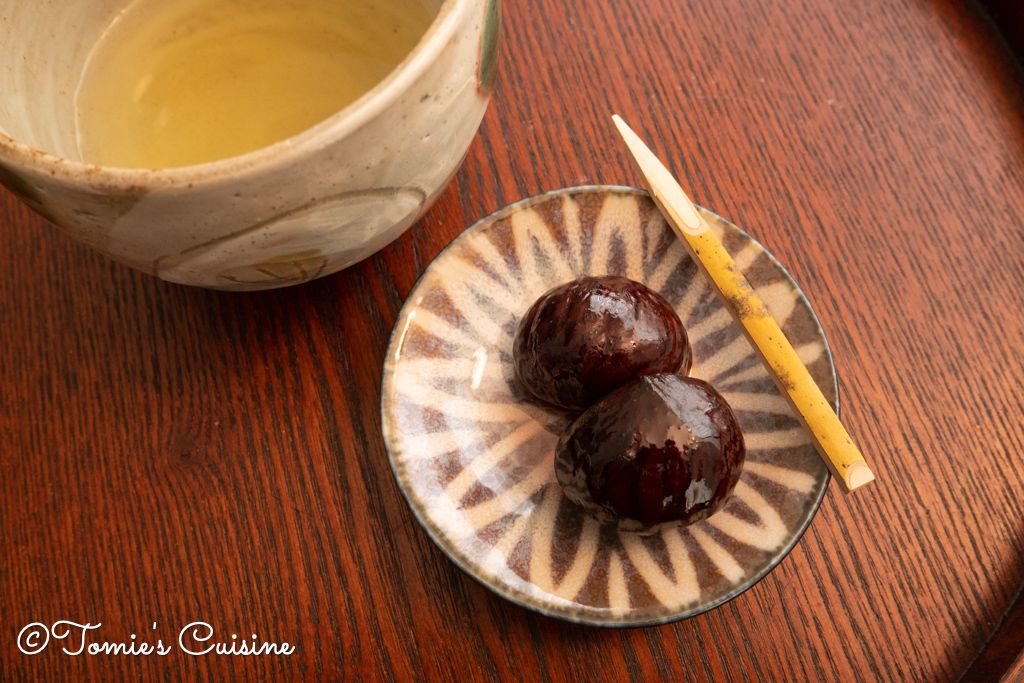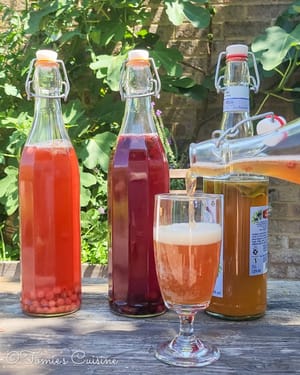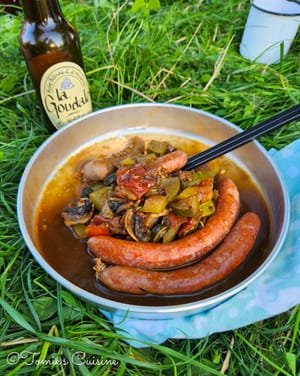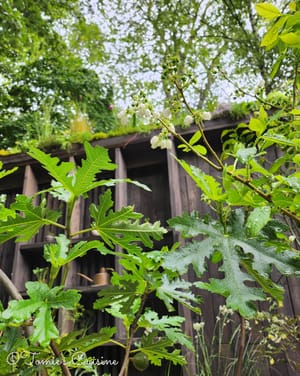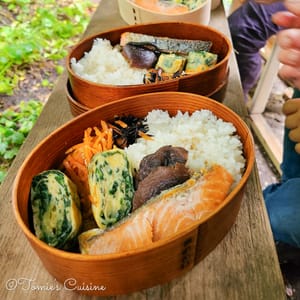Chestnuts and me
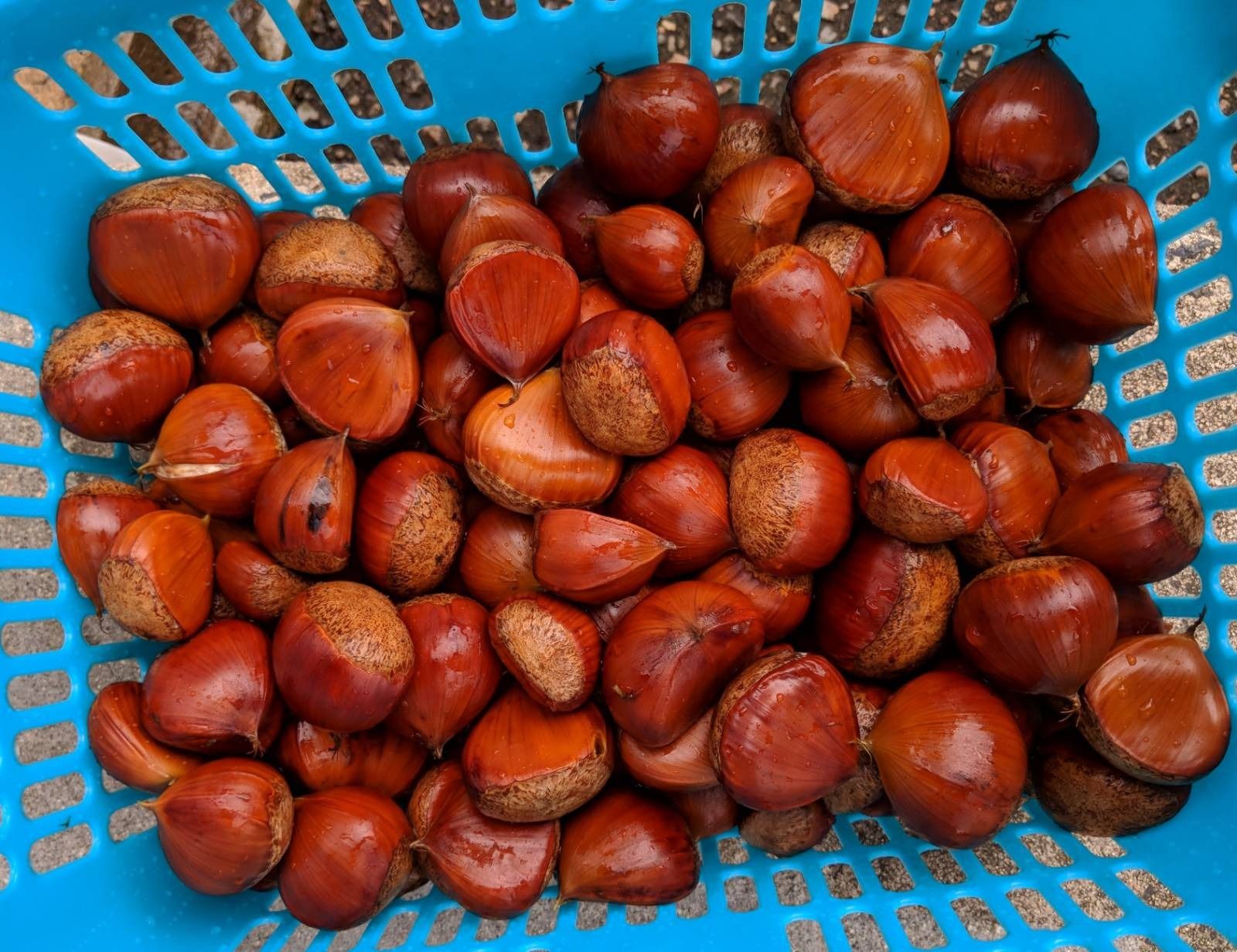
As far as I remember, my grandmother, who lives in the countryside in Japan, has been sending us a box of chestnuts in October that she handpicked around her house.
My mother prepared them using this “Shibukawa-ni” recipe, but now it’s mostly my father. He prefers making “Kuri-Kinton” with the chestnuts, though. Instead of making them candied, the chestnuts are cooked and mashed, mixed with sugar and shaped like chestnuts. Both are great partners for Japanese tea, especially with roasted green tea (Hojicha).
Three years ago, when I went back to Japan, it was the chestnuts season. So I made this Shibukawa-ni for the first time. It went well, so I gave some to my friends, and they still talk about it to this day. It’s been three years, though.
What is “Shibukawa-ni”?
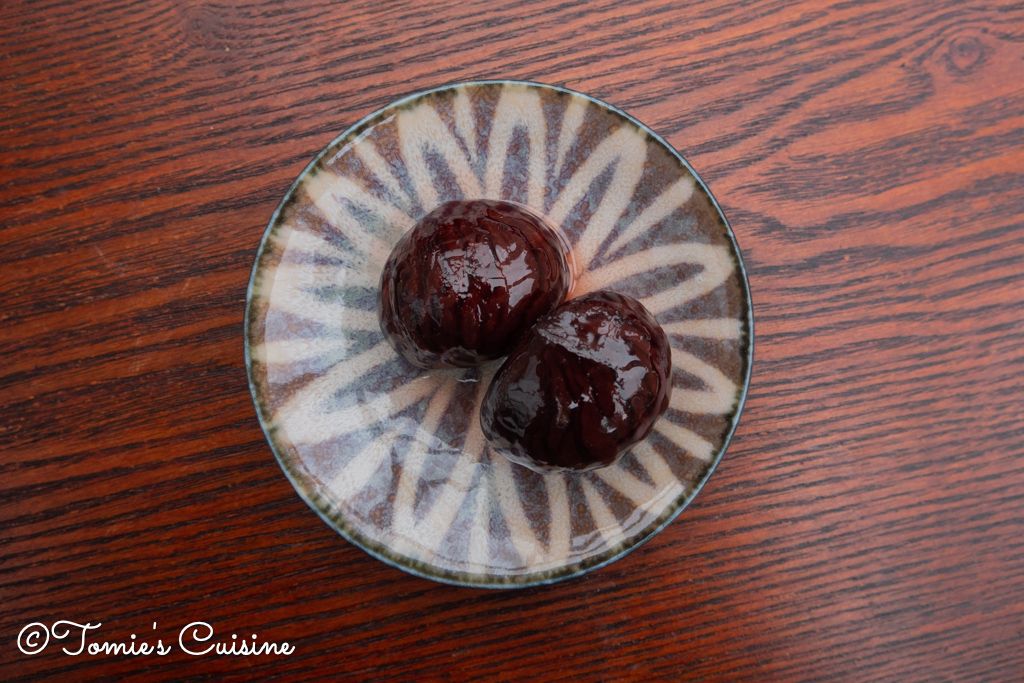
We often call them “Kuri-no-shibukawa-ni”.
Kuri = chestnuts
Shibukawa = the bitter inner skin
Ni = cooked
So when you put it all together, it’s cooked chestnuts with the inner skin. The inner skin is usually very bitter, but it contains tannin, one of the polyphenols. It’s known as an antioxidant.
I’ve seen some other Shibukawa-ni recipes from different websites, calling them “Japanese candied chestnuts”. I am not sure it’s “candied”, but these are glossy and sweet chestnuts. People often prepare them for dessert or store them to enjoy later.
Recipe
Ingredients
- 1.2kg Chestnuts
- 1 tablespoon x3 of Bicarbonate of soda
- Sugar: 50% of the final weight of the chestnuts
- Brandy or rum (optional)
Equipment
- Stainless steel or enamel pot
- Colander
- Two bowls
- Scale
- Knife
- A cocktail pick
Instructions
- Wash the chestnuts.
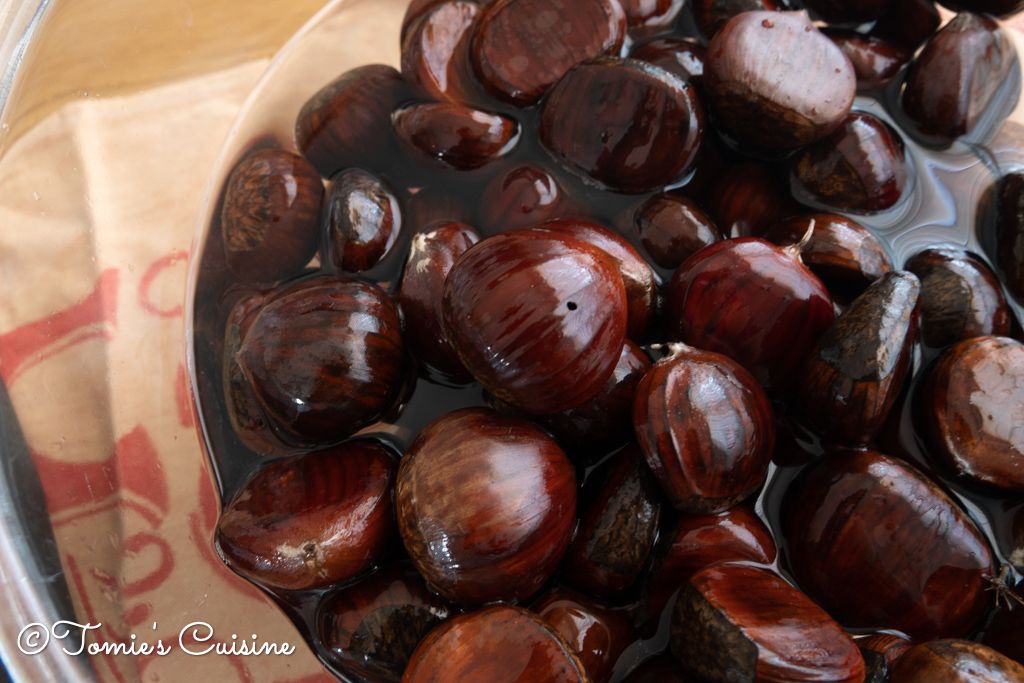
- Place the chestnuts into a bowl and fill with cold water to soak overnight. If any chestnuts are floating, avoid using them.
- Check for any holes or damage; if there are any, leave that chestnut aside. When there is a small hole in the chestnut, there is a worm in it most of the time.
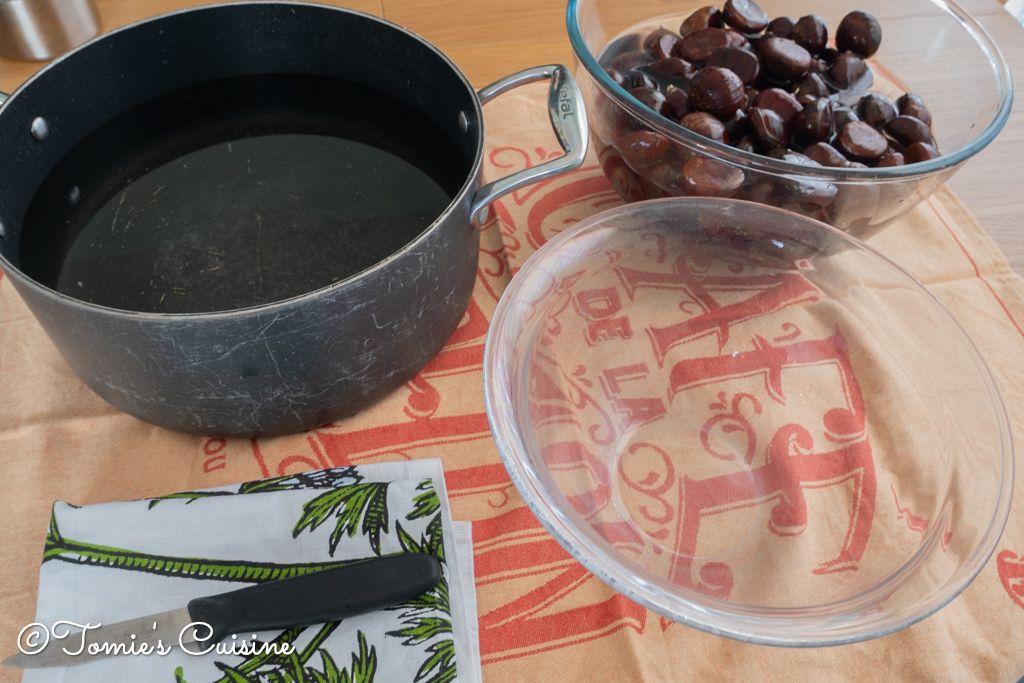
- Before starting peeling the chestnuts, prepare a pot with water to put the peeled chestnuts.
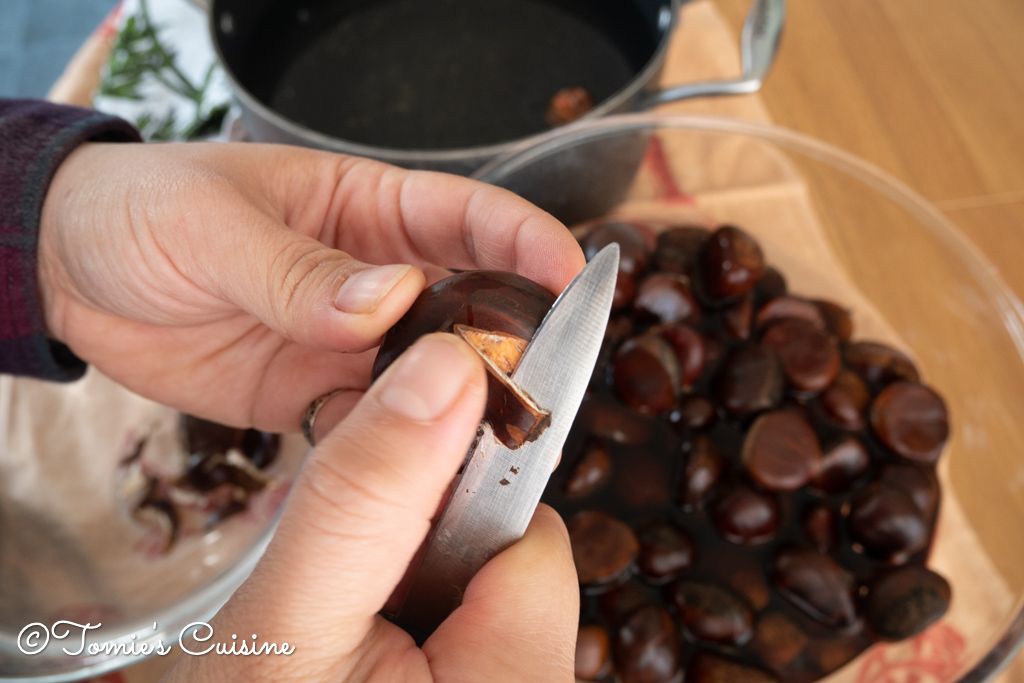
- Peel the chestnuts from the line between the shiny part and the rough part. (see the photo below) You can wear gloves to avoid cutting yourself. Peel the outer skin with care to not damage the inner skin; otherwise, the chestnut will break apart when cooking. The fresh chestnuts are more likely to split because they have thinner, more delicate inner skin.
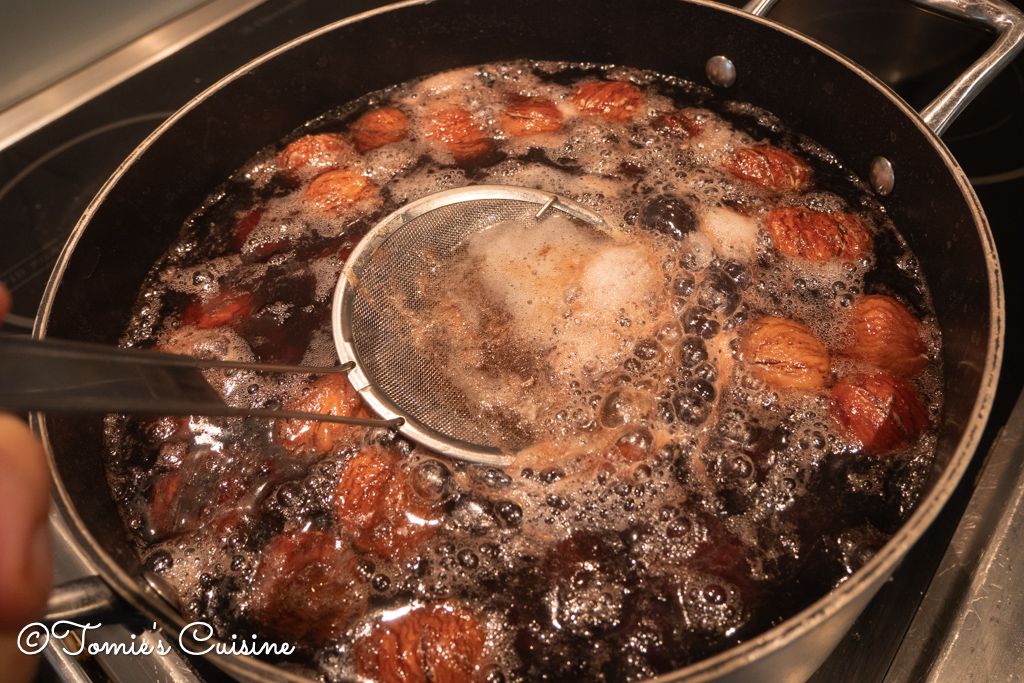
- Once you have peeled all the chestnuts, fill the pot with enough water to cover the chestnuts. Then add one tablespoon of bicarbonate of soda. Bring it to a boil and lower the heat to simmer for ten minutes. Please do not boil it too strong, or it will damage the chestnuts.
- Carefully drain the hot water and gently put the chestnut under the running water.
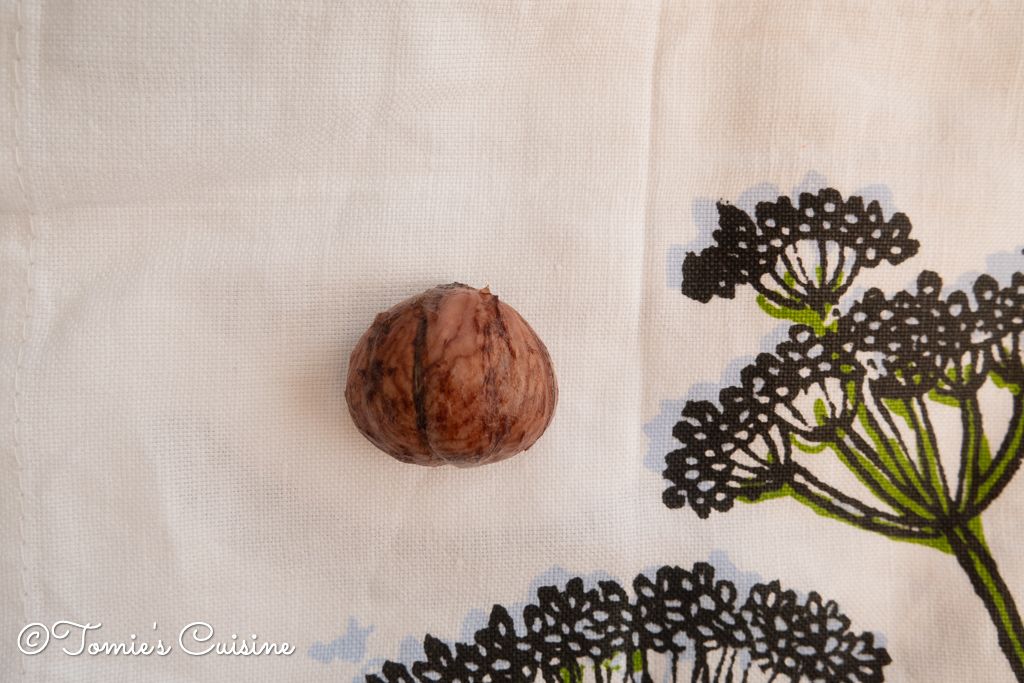
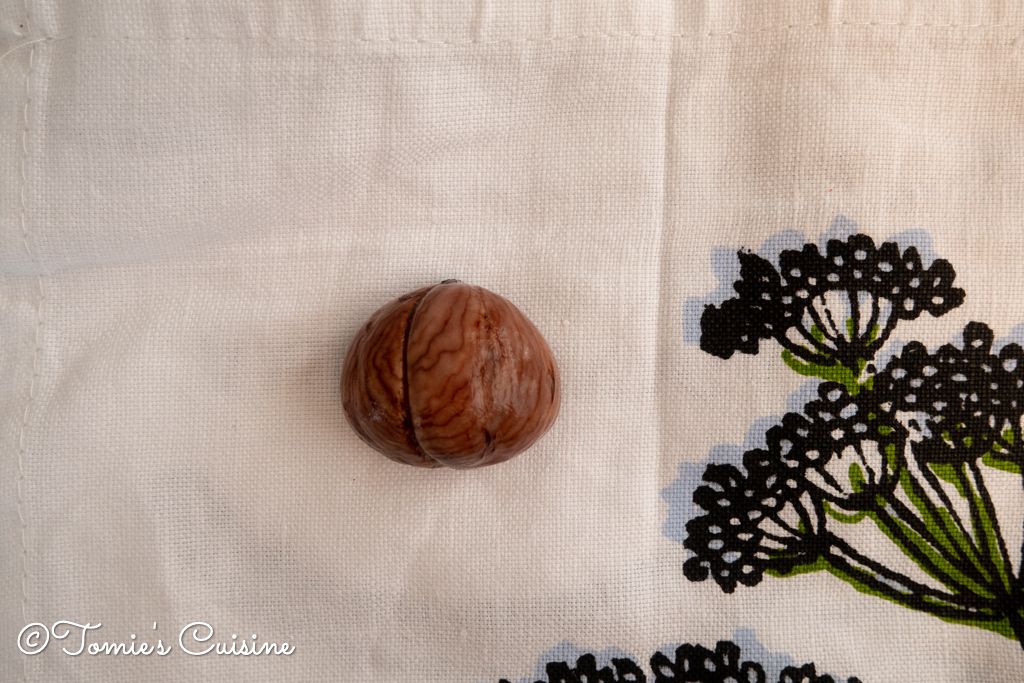
- Use your thumb to clean the chestnuts delicately. Finally, use a cocktail pick to remove the thick string on the skin.
- Rince the pot thoroughly and put the chestnuts back in, and repeat step 6. Depending on how hard the skin is, repeat these steps 2 to 3 times.
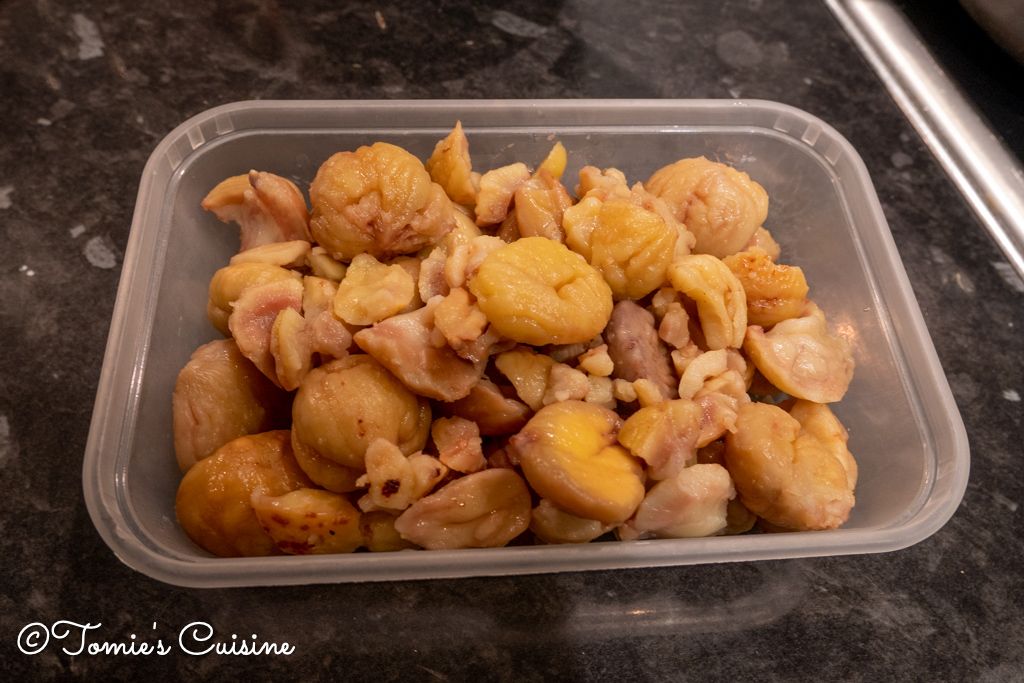
- The chestnuts are getting softer and more fragile, so be careful when you rinse the cooked chestnuts. If it’s broken, keep them on the side to use them for something else. (I froze them and made a chestnut paste to use to make sweets!)
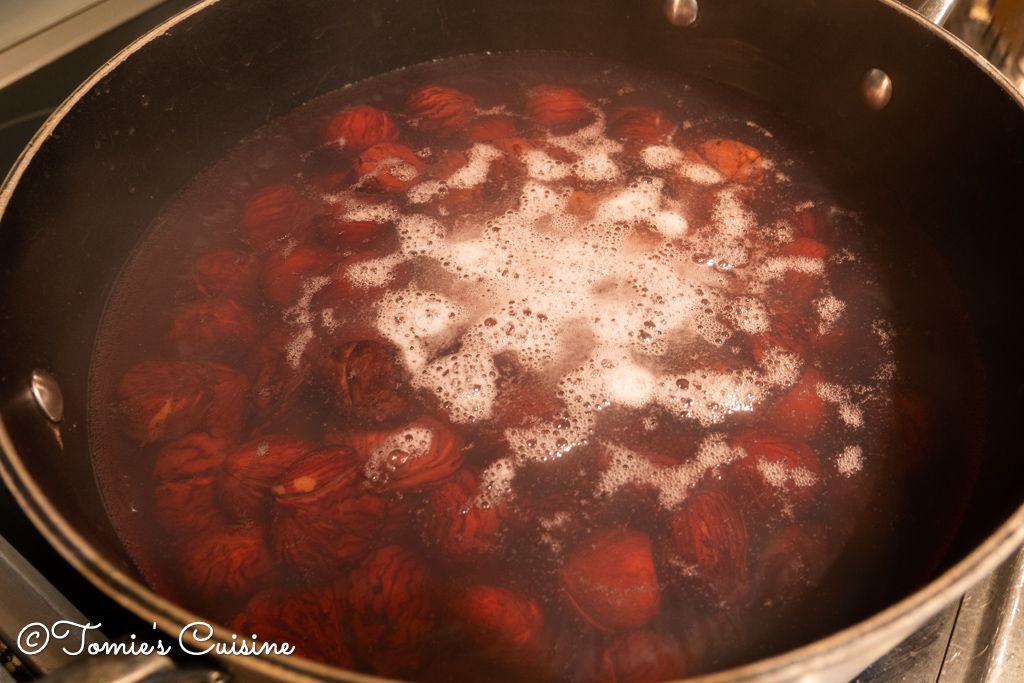
- Once you have finished, put the chestnuts into the washed pot, fill with water and bring it to boil and simmer for ten minutes. It is roughly the same process as step six but without the bicarbonate of soda. Repeat this two to three times until the water turns into a clear wine colour.
- Weigh the remaining chestnuts to see how much sugar we need to add. The amount of sugar is going to be 50% of the total weight of the chestnuts.
- Place the chestnuts into a pot and cover them with water and start cooking. Once it starts simmering, add ⅓ of the sugar. Add another ⅓ once the sugar has dissolved. Repeat this process until you have used all your sugar.
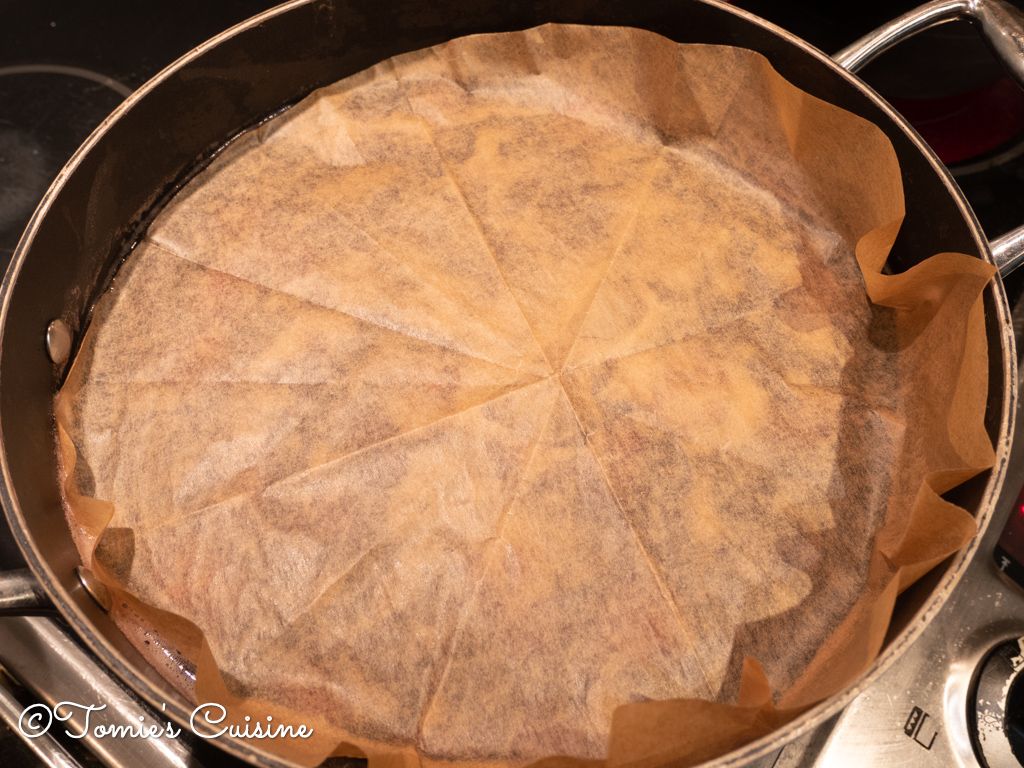
- Cook for 20 minutes with a gentle simmer using parchment paper as a drop lid (Otoshi-buta). Then check if you have cooked them properly. You can continue cooking slowly to reduce the water if you want a thicker syrup; remove the parchment paper if that’s the case.
- Optionally, add brandy or rum after turning off the heat.
How to clean the pot when it is stained with the chestnuts
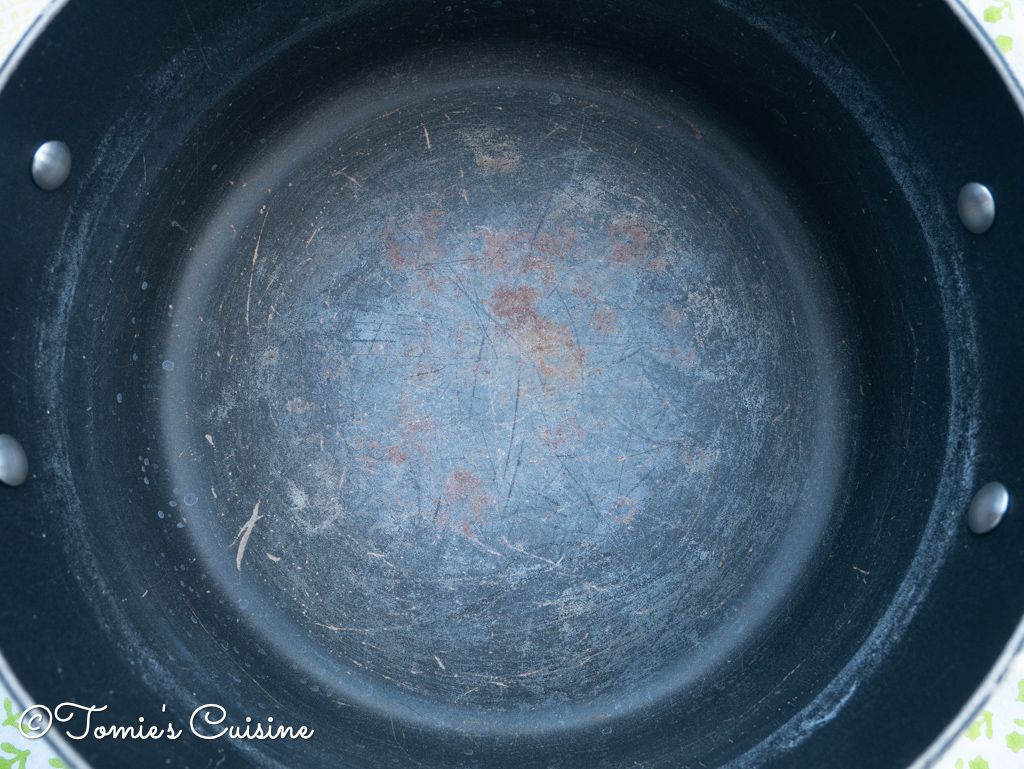
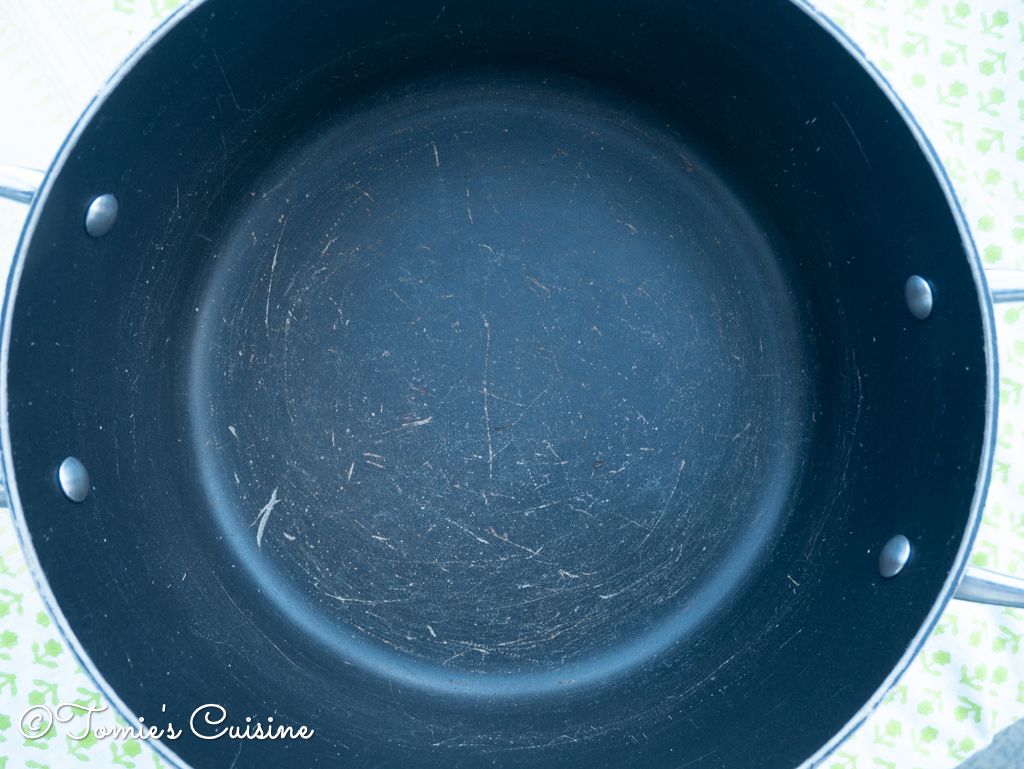
When cooking chestnut with the inner skin, you'll get a brown, red-ish stain on your pan or sink. It comes from the skin and is very difficult to remove with a sponge with liquid soap or even the dishwasher. But don’t worry, here are two methods you can use!
Bicarbonate
First, sprinkle some bicarb on the stained surface and scrub with my wet loofah sponge. This method worked well with my stainless steel pot but not the old Tefal pot.
Citric acid or distilled vinegar
I heard citric acid is working too, so I tried distilled vinegar. Pour some vinegar into the pot and bring it to a boil. Leave it to cool down and then scrub. It even removed the stain from this scratched Tefal pan that we have been using for almost ten years!
I tried to make this chestnut recipe with three different pans, and vinegar worked very well to remove the stains in each case.
There is an interesting anecdote from last week regarding removing stains from pans. My friends were visiting us and made some spaghetti with tomato ragu sauce. When they were preparing it, I wasn't at home because I was working. They picked a pot I used to make the chestnuts in and hadn't yet removed the stain. But when I came home and saw the washed enamel pot, it was spotless! Looking at the ingredients, Tomato contains citric acid, so that would make sense!
Closing words
I know there are many steps, but I think it’s the kind of recipe you prepare during a slow autumn day when you have time and want to use seasonal ingredients. That is why I love making Shibukawa-ni during the chestnuts season, as that is when it tastes the best. Not only that, but it brings me back to that particular box of chestnuts. I hope you will also create some great memories preparing these candied chestnuts too. If you do, please let us know on our Instagram, Pinterest, Facebook.
I plan to post more autumn recipes, including one using the broken chestnuts from the preparation, so don’t forget to subscribe to our email list so that you don’t miss any of our future updates.

